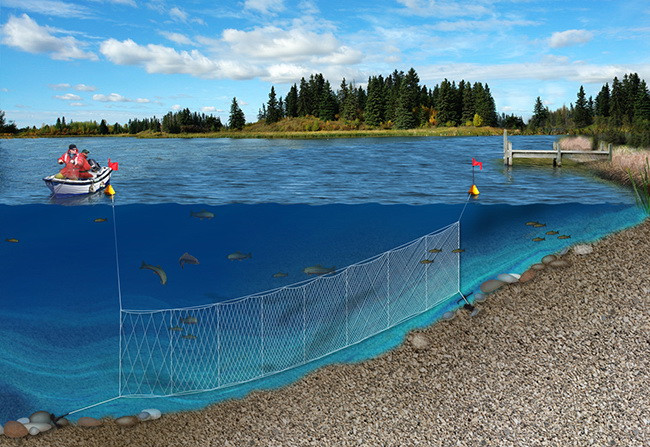Background
"How are the fish in my lake doing?" We need this answer to set management objectives and appropriate fishing regulations, to understand and correct any problems with fish habitat, and to guard against invasive species.
A healthy fish population and fish community means we can all enjoy the benefits of sustainable fisheries and healthy ecosystems. A standard method of assessing the status of fish populations is necessary to allow comparisons of fish sustainability across the years at a lake, and to compare to other lakes.
We use a North American accepted standard of index netting for lake fisheries assessment (Morgan, 2002). This method provides the necessary data on fish abundance, biological data (such as age and gender), and species diversity to assess sustainability.
These data, along with other information, supports assessments of fishery sustainability, and along with the Fisheries Management Objectives for a fishery, are used to determine the most appropriate sport fishing regulation. These assessments allow for consistent comparisons of fish sustainability and status between populations over time.
About Fall Index Netting (FIN)
FIN is used by the Alberta government to primarily monitor Walleye and Northern Pike populations.
FIN typically occurs during late summer and fall when water temperatures are between 10 and 15°C, when fish are known to be more evenly distributed within the lakes.
Standardized multi-mesh gill nets are set at random locations between 2 and 15 metres deep, set for 21 to 27 hours (for example: a net-night), and then reset in new random locations the next day. A half-length variation of the standard index net is sometimes used, balancing precision of the catch rates with reduced sampling effort.

Sampling effort is proportional to lake size, so larger lakes can require more nets. Information from Yellow Perch, Lake Whitefish, Burbot, minnow and sucker species are also collected. The information collected from each fish includes length, weight, age, gender and maturity.
How FIN information is used
Catch rates (for example: number of fish captured per net-night) of Walleye and Northern Pike are a measure of the population's abundance, with higher catch rates meaning there are more fish in the lake.
The abundance of adult fish is compared to the standardized thresholds for 5 broad categories of risk to the long-term sustainability of the fish population, with higher densities of fish having lower risk (Table 1).
The sizes and age of fish also tell us if problems with overharvest (for example: too few fish living to old age) or habitat (for example: poor spawning success) are a concern. Biologists use this information, as well as a variety of data on water quality, access, development, and habitat threats as part of Alberta's Fish Sustainability Index (FSI).
These assessments as well as the Fisheries Management Objectives are used to determine the most appropriate sport fishing regulations for a lake. This landscape-level assessment allows for consistent, broad temporal comparisons of fish sustainability and status.
For more information on fish conservation and management in Alberta, see:
Table 1. Alberta's Fish Sustainability Index risk thresholds for Walleye and Northern Pike using the standardized Fall Index Net (FIN) method.
| Mature Walleyes/net-night | Mature Pike/net-night | Risk to sustainability |
|---|---|---|
| >29 | >22 | Very low |
| 20 to 29 | 15 to 22 | Low |
| 15 to 20 | 11 to 14 | Moderate |
| 6 to 15 | 4 to 10 | High |
| Very high |